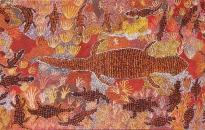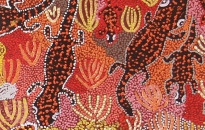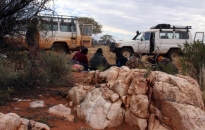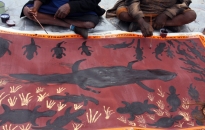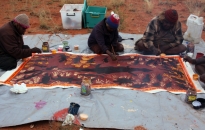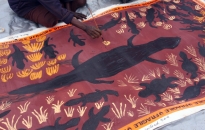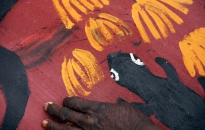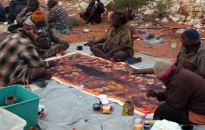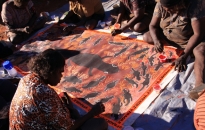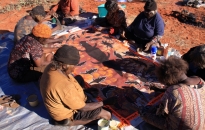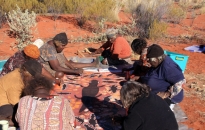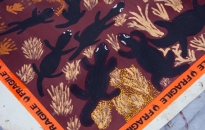Breaking Paradigms: Celebrating Aboriginal Women Artists
Aboriginal Australian Art reignited my passion for the arts; it is a thrilling journey of discovery and my personal choice in collecting has been to focus on the women artists. Why Aboriginal Art? Firstly, it is a paradigm breaker and secondly, it stands up to an analysis of art criticism.
To start, let’s look at the paradigms:
Aboriginal art is powerful contemporary art, having commanded auction prices of over 1 million AUD and being included in great museums and collections around the world.
This refutes the paradigm in the first half of the 20th C. that the apparently undeveloped material culture of the Indigenous Australians heralded an absence of culture and development (Contemporary Aboriginal Art, AAMU).
Aboriginal art has created a tidal shift in the arts. It is powerful, creative, dynamic and diverse. Certain Aboriginal artists, such as Emily Kame Kngwarrye, Eubena Nampitjin, Judy Napangardi Watson, have produced works that pass my “shimmering” test: their luminosity is such the viewer can feel the energy and movement radiating from the work.
This refutes the initial perception of some Aboriginal works in the first half of the 20th C. as the domain of anthropologists and ethnologists (Contemporary Aboriginal Art AAAMU). It is also testimony that artists of non-Western heritage are as capable of holding their own.
Aboriginal art is highly diverse in medium, content and age of the artists. Women are integral actors in Aboriginal art, often recognized as highly important tribal elders in law or medicine.
This refutes the paradigm held in certain other cultures or countries concerning the role of women. In some, women have had to fight for professional equality, equal pay or the vote. Both competent men and women are considered “old” professionally at 50 in areas of today’s Western world; the idea of starting to paint late in life (such as one’s sixties or seventies) and achieving recognition is generally not taken overly seriously.
Aboriginal art is rooted in history, testimony to a cultural history that is still evolving today. Spectacular rock art in Australia goes back over 20,000 years and can still be seen across the continent.
This refutes any notion that Aboriginal Art is but a recent creation and cannot be considered a serious movement.
From the ‘encounter’ with Europeans in the 20th C., Aboriginal artists began adapting to the new medium of contemporary art, inspired by their art passed on from generation to generation orally or visually during rituals and ceremonies.
Much of the subject matter is inspired by or represents an artist’s ancestral land, stories of creation or elements of rites and ceremonies, of the “Dreaming.” Initially drawn in sand or earth, on wood or the body, these traditional symbols and stories were often ephemeral. Aboriginal elders have ensured that as artists began transposing their knowledge, their cultural memory, to modern medium, the sacred and sometimes secret iconography is camouflaged.
In contrast, many trailblazer artists / art movements over the last 150 years of our Western European heritage fit into a logical consequence of individuals pushing back existing artistic frontiers after the invention of photography (first half of the 19th C.) and reacting to world events. French artists first began abandoning a realistic rendition and moved towards Impressionism, which heralded in 100 years of constant change as art evolved into greater abstraction. These years included movements as varied as Expressionism, Dadaism, Fauvism, Surrealist, Cubism, Futurism, Minimalists, Abstract Expressionism, Pop Art …
Certain masters of Modern art in the West have been inspired by “primitive” art, such as Picasso or Henry Moore – but theirs was an external borrowing of a concept that is, in contrast internal to Aboriginal artists – passed on from generation to generation.
Next, let’s discuss how Aboriginal art surpasses the analysis of art criticism. A critical eye expects mastery of color and brushstroke, use of space, creativity, a message, a certain gestalt and to show coherence and logic over time. Further, a successful artist commands respectable auction prices over time and is present in major private, public or corporate collections worldwide, such as the Art Gallery of NSW, the National Gallery of Australia, the National Gallery of Victoria, the Holmes a Court Collection (Perth), the Kaplan-Levi Collection (Seattle), the Vroom Collection or the AAMU in the Netherlands, le musée de quai Branly (Paris), Musée des Confluences (Lyon), Kluge Foundation (Virginia). An artist is also expected to be the object of solo exhibits and articles/publications and perhaps finalist or winner of major awards.
Let’s highlight several key women artists in Aboriginal Art whose work meets the above-mentioned expectations of art criticism. This art expresses the women’s stories and traditions of the land, and the Awelye (body painting). It expresses the strong sense of connection these artists feel to their land, to what is happening underneath the surface, to the traditions and stories. It can also tell a painful side of the Aboriginal history: being forced away from tribal homelands due to nuclear testing, mining, lack of water, or the later return of the control of communities to Aboriginal control.
Utopia
The mythic Emily Kame Kngwarrye “EKK” (c. 1919-1996) created sublime paintings representing Awelye and wild yam dreaming. In 2007, one of her works commanded 1.56 million AUD at auction – the highest price ever paid for a female Australian artist. Like Monet, her eyesight lessened in her last years, and her paintings are brilliant strokes of brush in intense, luminous colors. EKK posthumously represented Australia at the Venice Biennale in 1997.
Prominent artist Kathleen Petyarre (1940-) is a great community leader; she was active in the successful claim for title over the Utopia lease. Along with her sisters (artists Ada Bird, Nancy, Violet, Gloria Tamerre Petyarre) and brothers, Petyarre is owner or guardian of several dreamings, including her central Mountain Devil Lizard. Her signature works are made of shimmering layers of dots that provide a series of fine screens to camouflage the secret or sacred elements of her dreaming. Her paintings show subtle variations of tone and color; they portray a unique elegance, complexity and spiritual interpretation of the land. It is interesting to view the various artists’ distinctly different renditions of shared dreamings. Example: Gloria (c. 1940-) Petyarre’s vibrant, multi-layered orange- red painting represents bush medicine leaves compared to the elegant, sometimes cooler rendition by Abie Loy Kemarre (or Akemarr, c. 1972-, grand-daughter to Kathleen). Abie’s Awelye are powerful bold abstractions.
Warlukurlangu Arts Center, Yuendumu
The work of Judy Napangardi Watson (c. 1925-), a unique style of vibrant, explosive color, depicts women’s stories and ancestral land; their energy is captivating and shimmering.
Dorothy Robinson Napangardi (c. 1950) Paintings represent stories of her country – Mina Mina.
Rising star Andrea Nungarrayi Martin (1965-), work conveys energy and dynamic force.
Bidyadanga on the Kimberley coast
Senior law woman Weaver Jack (c. 1928-2010), placed a cross representing herself in her paintings, which became her signature. Her land is conveyed via vibrant colors of orange, green, turquoise and purple with white. Confidence shines through the works of Alma Webou Kalaju (c.1928 – 2009). A medicine woman with the ability to see in x-ray, Jan Billycan (c. 1930-), grew up in Great Sandy Desert in the North of Western Australia. Her works, even segmented into diptychs, are powerful demonstrations of color and stroke – the sand dunes, the water. Certain works of rising star Lydia Balbal (1958-) are similar to those of Rothko.
Warmun Art Center, East Kimberley
Central law woman and teacher Queenie McKenzie Nakarra (c. 1915-1998) began painting in the 1980s, often with softer colors of pinks and browns. Queenie had witnessed massacres in the 1920s and 30s of indigenous people, which found outlet in her work, as did stories of contemporary life in her land. Senior artist Lena Nyadbi is one of the artists commissioned to paint for the 2006 opening of the Musée de Quai Branly in Paris. Her deep knowledge of her cultural traditions results in an iconography inspired by spearhead and scarification marks that is an abstract interplay of black and white – its impact equal to that of any of the great contemporary artists in the West.
Balgo, Western Desert
Highly recognized senior law woman Eubena Yupinya Nampitjin (c. 1920) traveled through the Great Sandy Desert as a child. The signature of her striking works is rhythmical and free expression, bold colors of pinks, reds, oranges and yellows. The effect, luminous and shimmering, recalls the work of Emily Kame Kngwarre.
Beverly Springs (Ngarangarri country)
Derby artist Lucy Ward (c. 1920) whose works represent the Wandjina, traditional fertility and rain creation ancestors; her canvases are both structured and delightfully playful.
Alice Springs
Dorothy Robinson Napangardi (c. 1950) Paintings represent stories of her country, Mina Mina, and of the women walking and dancing. She has vivid memories of family life in the bush, with its bountiful foods, soak and waterholes. It was during this time that Dorothy Napangardi learned about the Dreaming even though this was restricted to a listening and learning phase; she was later permitted to depict her father’s and grandfather’s Dreaming. In 1910 and 1932 prospectors for gold rushed to the Warlpiri lands. In 1917, a pastoral settlement meant an increasing presence of non-Aboriginals. With the additional development of the cattle industry, the colonial expansion resulted in an expulsion of the Warlpiri from most of their homelands. Relations between the Warlpiri and the whites were often full of tension and suspicion, culminating in the Coniston Massacre in 1928. Dorothy and her family were pressured to settle in Yuendumu in the late 1950’s; the experience was so challenging at first that her family returned to their country on foot. The 1976 Land Rights enabled the return of the Warlpiri to much of their homeland. Later, Dorothy was highly influenced by the Baptist pastoralists at the settlement.
Napangardi began to paint around 1987. The initial stage of her paintings included vivid bush plum and banana paintings. Ten years later she moved towards the Women’s Digging Stick Dreaming that was passed down from her father’s side; her palette evolved as well to much more subdued colors, network of lines and mosaics, then mainly black and white grid patterns which portray her dreamings from an aerial perspective. The ritualistic ceremonies and knowledge of her people, even after living away from her country Mina Mina, remain an integral part of her work. To fully appreciate her art, it is important to understand the Women’s Dreaming and The Two Snake dreaming narratives, which provide strong social teachings of gender relations prescribed by the Law.
Napangardi’s memory has inspired powerful works that seem to dance in front of the viewer; many are spectacular abstract works even if the viewer does not know the narratives behind them. Her optical, geometric compositions are outstanding and in viewing Napangardi’s work retrospectively, the viewer can sense an artist who is continuously moving forward, blazing new territory.
Warakurna Artists, Central Desert region of WA
An impressive change of pace is the women’s collaborative work Minyma Lungkata Tjukurpa, 2010 (acrylic on canvas). Fifteen senior women from across the Ngaanyatjarra Lands, Warakurna and Wingelina created this large-scale painting after visiting the site of the Minyma Lungkata Tjukurpa (Mother Blue Tongue Lizard Dreaming).
Mornington Island, Queensland
Sally Gabori (Mirdidingkingathi Juwarnda Sally Gabori) (c.1924) spent her childhood on Bentinck Island with her people, the Kaiadit. After years of resistance and following a severe drought and cyclone, the Kaiadit were relocated to Mornington Island. Sally started painting in her early 80s; her strong connection to her land shines through her vibrant, colorful canvases. Her loose, confident brushstrokes tell her story of the oyster-encrusted stonefish traps, water, sun and fish of her country.
Gabori has carved out a special spot as a major player in the arts.
North East Arnheim Land, Northern Territory
Gulumbu Yunupingu (1945-2012), or the star shining from the North; Gulubu was one of the eight artists invited to create works for the 2006 opening of the musée du quai Branly in Paris. She created a vast star-filled universe, “garak” on the ceiling, an image of what we see in the night sky. The speech Gulumbu made at the opening ceremony brought many people listening to tears: she emphasized the importance of sharing her art and culture with the world in order for future generations to see and understand them. “This is my gift to you, the French people, and to the people of the world. This is my heart.” She said that once she would be physically gone from this earth, her spirit would take its place with her ancestors in the sky above the Earth – the sky everyone sees at night, no matter what country around the world. For her, it reinforced the fact that people should work towards harmony.
Gulumbu’s stated credo: “The truth lies in what every artist has to say; there is healing for people when they see beauty”.
Gulumbu’s signature style of lines and dots (inspired by Arnhem’s traditional rarrking) represents the innumerable constellations in the universe. Whether on bark paintings, memorial poles (larrakitj), didgeridoos or weaving mats and baskets; Gulumbu’s work is inspired by an important ancestral story her father would tell her as a child in Arnhem Land. He explained that they were very special wishing stars, which impact the replenishment of natural resources. Gulumbu’s works transpose us – we feel as though we are gazing with wonder at the infinity of the endless sky on a clear night – there is a mystery, a spiritual aspect.
Gulumbu came from the distinguished Yolngu dynasty; she was an important leader in her community at Yirrkala. Her father, Mungurrawuy Yunupingu (c. 1907-1978), was an activist in the clan’s 1963 political initiative presenting the Yirrkala Bark Petitions to the Federal Government in protest of the use of their lands for mining; he remains an accomplished and renowned artist. This Petition was a landmark example of the power of visual art and culture of the Yolngu people to exemplify their land rights within the Australian constitutional and legal system.
A visit to Quai Branly is a must; the full potential and scope of Gulumbu’s work shines through brilliantly on this ceiling installation. The lighter “hidden” stars create rich depth and we can almost feel ourselves evolving into a new star in the constellation.
Near Darwin, NT
Regina Pilawuk Wilson (1945-), a founding member (with her late husband Harry) of Peppimenarti community, initially weaved baskets, fishnet and dilly bags and mats. She has transferred her skill from 3-dimensional objects to 2-dimensional canvases and fabrics. Regina’s weaving heritage, rooted in intricate patterns, engenders a strikingly new style of painting that is joyous and luminous.
Conclusion
This article is by no means exhaustive – there are multiple other women artists to discover and follow as well multiple media used by the artists. I hope you will agree that Aboriginal Art is a paradigm breaker and that it meets the criteria in the exercise of critiquing art. It has proven its weight on the art market. Aboriginal art promises to continue to lead us on a visual journey as artists test new media and intermingle with other cultures.
Michele McCabe
References:
1) PETITJEAN, Georges. Contemporary Aboriginal Art, The AAMU and Dutch Collections, Utrecht, 2010
2) MCCULLOCH, Susan and Emily. McCulloch’s Contemporary Aboriginal Art, 2008
3) NICHOLLS, Christine & NAPANGARDI, Dorothy. Dancing Up Country: The Art of Dorothy Napangardi, The Museum of Contemporary Art, Sydney, 2002
4) LAVERTY, Colin & Elizabeth. Beyond Sacred, The Collection of Colin and Elizabeth Laverty, 2008
5) Australian Indigenous Art Commission, Musée du Quai Branly
6) Major Australian Art Gallery websites
About the Author:
Michele McCabe is an American Collector of Aboriginal women art since 2006.
Artwork © The Artist
